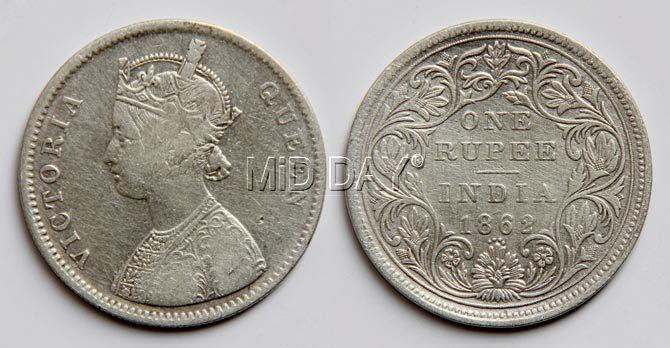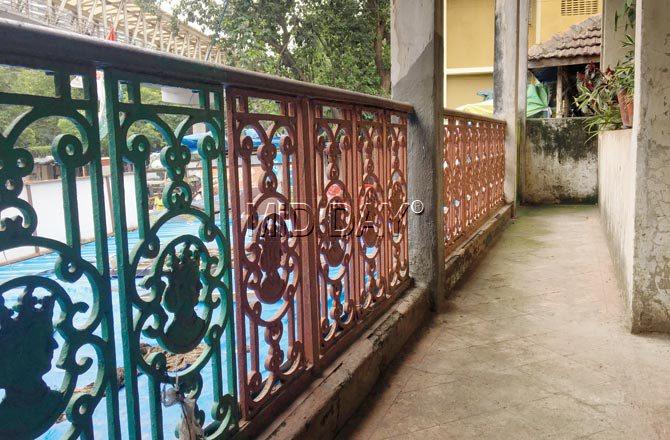On balconies and balustrades, a reminder of the city's industrial heritage and the colonial era lives on

Detail of a series of cast iron railings depicting the regal figurehead at a building in Grant Road (below right). Pic/Bipin Kokate
The Queen lives on in Mumbai. Post-colonial cities rarely wipe out the memory of their former monarchs, and nothing could be a finer example than Mumbai, where the vestiges of the British Empire are mired in controversy. It's why statues are shunted around and railway stations are renamed. But, when the English hope their queens will live long, they are not joking.
There is no cause for alarm, though. All that we are referring to are cast iron railings seen on balconies, balustrades and porches, in old buildings and bungalows, stretching right from Fort to Malad. These inconspicuous railings are the last places that we'd expect Queen Victoria, the former Empress of India, to be iconicised. And, even as they fight a bitter battle against time and rust, these railings are garnering a lot of attention, right from history buffs on social media to inspiring designs for wall-hangings.
ADVERTISEMENT

Cast iron railings in a Malad bungalow
Mumbai experts, Aadil Desai and Deepak Rao, rattle off the number of places where this particular style of railings can be spotted. It's not an easy task. Despite their ornate design, with the regal figurehead in the centre, these railings are like any other — buried under a mess of hoardings, wires, tarp, trellises and cloth lines.
Changing lifestyles
Desai and Rao point us in the direction of Byculla, to Love Lane. Here is the Regina Pacis Convent, the erstwhile home of "Cotton King" Premchand Roychand. On the convent grounds is a building overlooking the Byculla Police Station, where some of the last remnants of these regal railings can be seen. It is speculated that the building was once the servant quarters of the Roychand household, and was converted into a residential and commercial property upon sale to the convent.

Bearing the Gothic portrait of Queen Victoria, as seen in the Indian regal issue of coins of 1862
A long-time resident of Regina Pacis Building, Vishwas Waman Deshpande, 61, tells us that it was probably constructed around 1860 and that the first floor corridor was lined with these railings. "However, 80 per cent of it is gone. People extended their flats till the common corridor and built new walls after removing the railings," he says. In 2008, Deshpande extended his living room till the corridor. He doesn't have the railings anymore. "The contractor took them away with him," he tell us, wondering if there was much sense in preserving these rusting railings.
Cast iron railings, including the regal impression, are a part of our industrial heritage, says conservation architect Vikas Dilawari. They came in big way in mid-19th century and residential architecture picked them as an integral feature of buildings, bungalows and chawls. Initially imported from Glasgow and other parts of the UK, they were later manufactured in Richardson and Cruddas in Byculla. But lifestyles have changed, says Dilawari.

A less ornate but similar design seen in cast iron railings in a cottage near Bandra railway station. Pics/Nimesh Dave
"These belonged to a time when seating habits meant squatting on the floor, and you could allow the breeze to come through the railings. Now, everyone wants space, a boxed balcony, and an air-conditioner. Naturally, and sadly, these [railings] are going" he says. But, is the crowned bust moulded on these railings really the former Empress of India? Desai tells us, "I am not sure if it is Queen Victoria herself. It is more likely that these are a homage to the Crown rather than the Queen specifically."
A clue from coins
The answer might lie in another metallurgical product — coins. We got close to two versions of the railings, one in Malad and one in Bandra, both among the best preserved of the lot. The example in Malad lines the porch of an old bungalow, which partially functions as a gym. On that, says numismatist Pascal Lopes, is Queen Victoria. It is comparable to the profile seen in the regal issue coins of 1862 in India, on which a young Queen Victoria was minted. Lopes explains that the regal issue, minted in Bombay, Calcutta and Madras, followed the style of the crowned effigy that first appeared in English currency in the mid-1800s, during the Gothic revival.

The Gothic portrait in the English currency was created by Royal Mint engraver, William Wyon and was introduced first in 1847. The portrait featured an ornate crown and a dress embroidered with roses, thistles and shamrocks, the national plants of England, Scotland and Ireland. When the Gothic portrait appeared on English currency in the mid-1800s, it was so after a gap of nearly 200 years that a crowned monarch was featured in a coin. It was otherwise unusual to see Queen Victoria bearing her regal headgear (East India Company coins, for instance, paid homage to a maidenly crownless portrait of the Queen).
In India, the Gothic style was engraved by LC Wyon of the Royal Mint, London, and was modified by Calcutta Mint's head engraver, Kashinath Das. The difference between the two engravers can be identified from the robe design of the queen, says Lopes, just as in the many versions of the railing portraits, too.
In Bandra, you can spot the other example in a bungalow near the railway station. The house, as far as the owner knows, dates back to the early 1900s. But, of the cast iron railings — their history is unknown, he says. Here, the queen's face is not well-etched, although she still bears a striking resemblance to the original portrait. There are also other examples in the city, where the profile looks to the right, instead of the formal left.
"Unless the railings have been installed wrongly, that's usually not the case. The face appears a little masculine, too. It is likely that these were copies made by local grill makers," says Lopes. Whether historical heritage or copies of the legacy, we still have the Queen for company. She may be a little rusty, but she peeks out from under AC units and cloth lines, reminding us, cheekily, of an era gone by.
Catch up on all the latest Mumbai news, crime news, current affairs, and also a complete guide on Mumbai from food to things to do and events across the city here. Also download the new mid-day Android and iOS apps to get latest updates
 Subscribe today by clicking the link and stay updated with the latest news!" Click here!
Subscribe today by clicking the link and stay updated with the latest news!" Click here!







